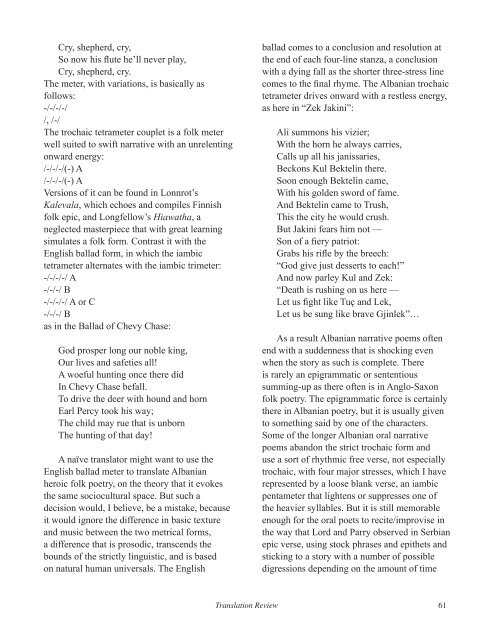Table of contents - The University of Texas at Dallas
Table of contents - The University of Texas at Dallas
Table of contents - The University of Texas at Dallas
Create successful ePaper yourself
Turn your PDF publications into a flip-book with our unique Google optimized e-Paper software.
Cry, shepherd, cry,<br />
So now his flute he’ll never play,<br />
Cry, shepherd, cry.<br />
<strong>The</strong> meter, with vari<strong>at</strong>ions, is basically as<br />
follows:<br />
-/-/-/-/<br />
/, /-/<br />
<strong>The</strong> trochaic tetrameter couplet is a folk meter<br />
well suited to swift narr<strong>at</strong>ive with an unrelenting<br />
onward energy:<br />
/-/-/-/(-) A<br />
/-/-/-/(-) A<br />
Versions <strong>of</strong> it can be found in Lonnrot’s<br />
Kalevala, which echoes and compiles Finnish<br />
folk epic, and Longfellow’s Hiaw<strong>at</strong>ha, a<br />
neglected masterpiece th<strong>at</strong> with gre<strong>at</strong> learning<br />
simul<strong>at</strong>es a folk form. Contrast it with the<br />
English ballad form, in which the iambic<br />
tetrameter altern<strong>at</strong>es with the iambic trimeter:<br />
-/-/-/-/ A<br />
-/-/-/ B<br />
-/-/-/-/ A or C<br />
-/-/-/ B<br />
as in the Ballad <strong>of</strong> Chevy Chase:<br />
God prosper long our noble king,<br />
Our lives and safeties all!<br />
A woeful hunting once there did<br />
In Chevy Chase befall.<br />
To drive the deer with hound and horn<br />
Earl Percy took his way;<br />
<strong>The</strong> child may rue th<strong>at</strong> is unborn<br />
<strong>The</strong> hunting <strong>of</strong> th<strong>at</strong> day!<br />
A naïve transl<strong>at</strong>or might want to use the<br />
English ballad meter to transl<strong>at</strong>e Albanian<br />
heroic folk poetry, on the theory th<strong>at</strong> it evokes<br />
the same sociocultural space. But such a<br />
decision would, I believe, be a mistake, because<br />
it would ignore the difference in basic texture<br />
and music between the two metrical forms,<br />
a difference th<strong>at</strong> is prosodic, transcends the<br />
bounds <strong>of</strong> the strictly linguistic, and is based<br />
on n<strong>at</strong>ural human universals. <strong>The</strong> English<br />
ballad comes to a conclusion and resolution <strong>at</strong><br />
the end <strong>of</strong> each four-line stanza, a conclusion<br />
with a dying fall as the shorter three-stress line<br />
comes to the final rhyme. <strong>The</strong> Albanian trochaic<br />
tetrameter drives onward with a restless energy,<br />
as here in “Zek Jakini”:<br />
Ali summons his vizier;<br />
With the horn he always carries,<br />
Calls up all his janissaries,<br />
Beckons Kul Bektelin there.<br />
Soon enough Bektelin came,<br />
With his golden sword <strong>of</strong> fame.<br />
And Bektelin came to Trush,<br />
This the city he would crush.<br />
But Jakini fears him not —<br />
Son <strong>of</strong> a fiery p<strong>at</strong>riot:<br />
Grabs his rifle by the breech:<br />
“God give just desserts to each!”<br />
And now parley Kul and Zek:<br />
“De<strong>at</strong>h is rushing on us here —<br />
Let us fight like Tuç and Lek,<br />
Let us be sung like brave Gjinlek”…<br />
As a result Albanian narr<strong>at</strong>ive poems <strong>of</strong>ten<br />
end with a suddenness th<strong>at</strong> is shocking even<br />
when the story as such is complete. <strong>The</strong>re<br />
is rarely an epigramm<strong>at</strong>ic or sententious<br />
summing-up as there <strong>of</strong>ten is in Anglo-Saxon<br />
folk poetry. <strong>The</strong> epigramm<strong>at</strong>ic force is certainly<br />
there in Albanian poetry, but it is usually given<br />
to something said by one <strong>of</strong> the characters.<br />
Some <strong>of</strong> the longer Albanian oral narr<strong>at</strong>ive<br />
poems abandon the strict trochaic form and<br />
use a sort <strong>of</strong> rhythmic free verse, not especially<br />
trochaic, with four major stresses, which I have<br />
represented by a loose blank verse, an iambic<br />
pentameter th<strong>at</strong> lightens or suppresses one <strong>of</strong><br />
the heavier syllables. But it is still memorable<br />
enough for the oral poets to recite/improvise in<br />
the way th<strong>at</strong> Lord and Parry observed in Serbian<br />
epic verse, using stock phrases and epithets and<br />
sticking to a story with a number <strong>of</strong> possible<br />
digressions depending on the amount <strong>of</strong> time<br />
Transl<strong>at</strong>ion Review 61

















